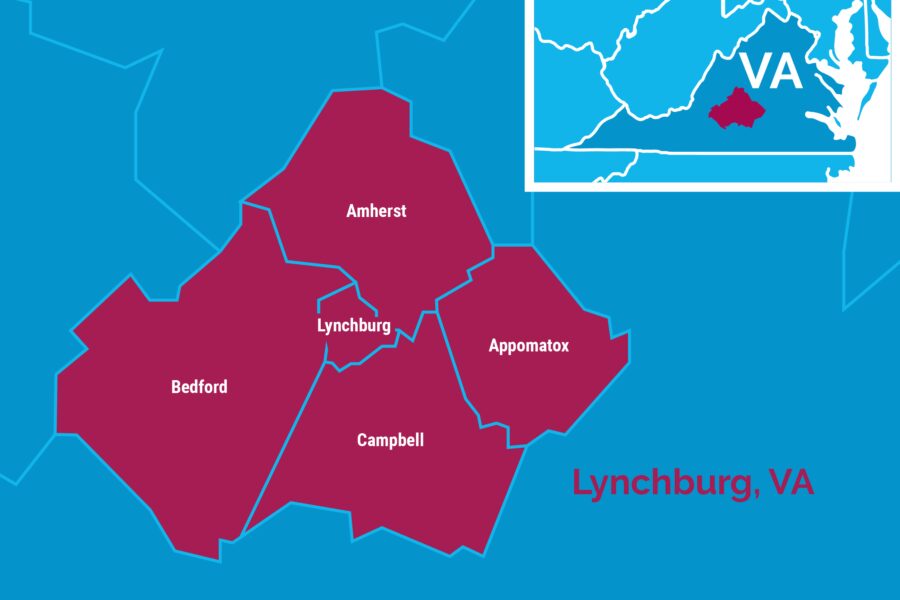COVERAGE AREA
Cities: 1
Counties: 4
Total Population: 261,214
The Achievement
FUNCTIONAL ZERO FOR VETERAN HOMELESSNESS
- Milestones Reached: Veteran (2020)
- Next Population for Focus: Sustaining functional zero for veterans and reaching functional zero for chronic homelessness
In February of 2020, the Central Virginia Continuum of Care became the 12th community in the United States to end veteran homelessness as a part of Built for Zero, a movement of more than 80 cities and counties in the U.S. committed to measurably ending homelessness, one population at a time.
By reaching functional zero for veteran homelessness, the community has proven it has built a system that can ensure homelessness is rare and brief, even if new veterans experience housing crises over time. This means that the Lynchburg community has fewer veterans experiencing homelessness than can be routinely housed within a month, which is three veterans.
Since joining Built for Zero in October 2018, the Lynchburg area team has housed 50 veterans, and they have reduced the average length of time from identification of a veteran experiencing homelessness to housing placement to 51 days.

How did they do it?
As part of Built for Zero, the Lynchburg team changed how its homeless response system works by adopting the core elements of the Built for Zero methodology:
- Building a unified regional team, or a “command center,” around a shared aim of getting to functional zero
- Using real-time, person-specific data to know every person experiencing veteran experiencing homelessness by name and target efforts and resources accordingly
- Using data to redesign Lynchburg’s homeless response and strategically target resources
BUILDING A COMMAND CENTER
The local Built for Zero team started by unifying the efforts of 32 key agencies working locally to end homelessness. In many communities, local agencies or nonprofits focus on their piece of the solution, without an ability to see how all the pieces in their community fit together. Often, success is defined by each organization’s programmatic goals rather than whether the overall number of people experiencing homelessness is going down.
Beginning in September 2019, community partners in Lynchburg and the four surrounding counties worked to reorganize their efforts around a shared goal of getting to zero veteran homelessness, beginning by building a closer relationship with their local Supportive Services for Veteran Families (SSVF) provider and bringing all of the key actors together for weekly “veteran huddles,” also known as case conferencing meetings.
By working more closely with the VA, employment specialists, and other agencies, the team was able to work from the same information about veterans in their community and focus in-depth on each veteran. Ultimately, this shortened the length of time a veteran would be homeless.
By demonstrating that they had the data, the will, and the right people at the table, the Lynchburg team was able to bring their local veteran council, a peer support organization made up of veterans, on board to join their weekly huddles.
“When the vet council started participating in our weekly veteran huddles and seeing how successful we were in housing placements, they became committed partners,” said Sarah Quarantotto, Executive Director of Miriam’s House. “They saw the value of what we were doing with Built for Zero and joined our efforts to end veteran homelessness.”
UNDERSTANDING THE PROBLEM THROUGH QUALITY REAL-TIME DATA

You cannot solve a problem that you don’t understand. In order to measurably end homelessness, communities need real-time, person-specific data. Traditionally, an understanding of the issue of homelessness in a community has been limited to an annual estimate of people experiencing homelessness, called the point-in-time count. This is an aggregate number that provides an estimate of people experiencing homelessness on a single night, but does not include the names or needs of the people who make up that number.
Communities in Built for Zero develop by-name lists, which provide real-time insights into everyone experiencing homelessness by name. This enables communities to triage that individual’s needs, understand if their investments and activities are driving homelessness down and test and innovate ideas that will move people out of homelessness faster.

By January 2019, the Lynchburg team had developed the framework that ensured quality data on every veteran experiencing homelessness. This data would enable them to understand who was moving out of homelessness, who was entering into it, and who was remaining on the list.
Before this, the Lynchburg team wasn’t always aware of how many veterans were experiencing homelessness in their area, since their veteran homeless service providers were out of the area and did not enter data into their local homeless management information system.
At the fall 2018 Built for Zero Learning Session, the team connected with a leader at their local HUD-VASH service provider, where they explained how beneficial it would be to have and use the same data they were using about homeless veterans in their community. Once that service provider agreed to enter their data in the shared management system, their local SSVF provider soon followed. The team was actually surprised once they discovered the actual number of veterans experiencing homelessness in their area.
“It was helpful to, at any moment, be able to pull a report and understand comprehensively how many veterans we were serving,” said Sarah Fuentes, Homeless System Coordinator, Miriam’s House.
One main source of inflow into homelessness stemmed from veterans “passing through” their community from other areas. In order to determine who was actually living locally, they built in a 5-day window before adding someone to the by-name list to ensure that the homeless veteran was in need of services in their area. They also began verifying veteran status through SQUARES (a VA web application for verifying veteran eligibility) before adding someone to their by-name list to ensure only veterans were on the veteran list. This revealed that their numbers were smaller and more manageable than they had previously thought.
“That really started tightening up our understanding of what veterans were homeless in our community, and then what needed to happen in order for them to get into housing,” explained Fuentes.

USING DATA TO REDESIGN LYNCHBURG’S HOMELESS RESPONSE AND TARGET RESOURCES
Once the team had their “command center” formed with the key veteran service providers at the table, all using the same quality by-name list data, they began to test and improve their system.
Those who comprised the command center — outreach workers, employment specialists, the veteran council, housing providers and other veteran partners — were each assigned specific goals to help fill gaps and overcome barriers to housing. “Every member of the veteran huddle was really committed to improving housing placements for homeless veterans and each had a unique service and skillset to offer to make that a reality,” said Sarah Quarantotto.
Another strategic system improvement was adding target housing dates to the names of each veteran on their by-name list, which expedited housing placements. “Setting housing target dates was very helpful in giving the group accountability and a shared goal which allowed us to work backwards to make changes and identify barriers and opportunities,” said Fuentes.
The team continued to hold and improve their weekly case conferencing meetings, which their coach Garen Nigon described as “excellent and action-focused.”
Another important change idea the team tested was related to outreach, deciding to reduce their inactivity policy from 90 to 45 days. Using historical data, the team realized that persons who were unable to be located between 45-90 days were not resurfacing as homeless but had rather self-resolved or left the area. To better target resources, the team reduced the inactive policy to 45 days to focus housing assistance on currently homeless veterans. For example, by moving veterans to the “inactive” list after 45 days instead of 90 days, the outreach team was better able to spend time engaging veterans in the community rather than allocating the majority of their time to locating veterans.
What’s Next
SUSTAINING AND EXPANDING

When the COVID-19 pandemic began, the team was worried their progress would backslide and not be able to hit their goals. “But when we really looked at the data, we still were seeing a steady decrease and maintaining that functional zero number,” said Fuentes.
The Central Virginia Continuum of Care is now working to sustain functional zero through continued community alignment. They also intend to actively maintain high levels of communication, partnership, and engagement with their local veteran providers.
Due to the COVID-19 pandemic, there is concern about inflow to homelessness, particularly with the eventual lifting of eviction moratoria and a potential economic recession. Nonetheless, the team continues to strengthen their case conferencing practice and problem-solve virtually. Lynchburg’s next goal after sustaining functional zero for veteran homelessness is to end chronic homelessness.
Timeline
2018
- October: Lynchburg joins Built for Zero
2019
- January: Community established a quality By-Name List and joined the Last Mile coaching cohort
- June: BFZ Staff onsite to generate buy-in and excitement around the goal of reaching functional zero for veteran homelessness
- September: Started case conferencing the veteran BNL weekly with all veteran service providers.
2020
- February: Lynchburg area ended veteran homelessness
Who was on the team?
Community and Data Lead:
Kristen Nolen
Director of Housing Services
Miriam’s House, Inc.
Sarah Fuentes
Homeless Systems Coordinator
Miriam’s House, Inc.
The Veteran Improvement Team:
Evelyn Jordan
Lead Case Manager
SSVF
TAP
Kate Donaldson
Social Worker/HCHV Homeless Outreach Worker
Salem VA Medical Center
VASH Representative
Sarah Quarantotto
Executive Director
Miriam’s House, Inc.
CoC Champion Lead
MaryJane Dolan
City of Lynchburg
Mayor
Michele Bauman, LPC
Street Outreach Worker
Community Access Network
CoC Street Outreach Lead
Built for Zero Coach:
Garen Nigon
Improvement Advisor for Built for Zero




